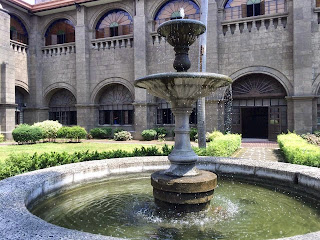San Agustin Church (Spanish: Iglesia de la Inmaculada Concepción de María de San Agustín) is a Roman Catholic church under the auspices of The Order of St. Augustine, located inside the historic walled city of Intramuros in Manila.
The present structure is actually the third Augustinian church erected on the site. The first San Agustin Church was the first religious structure constructed by the Spaniards on the island of Luzon. Made of bamboo and nipa, it was completed in 1571, but destroyed by fire in December, 1574 during the attempted invasion of Manila by the forces of Limahong. A second church made of wood was constructed on the site. This was destroyed in February 1583, in a fire that started when a candle set ablaze the drapes of the funeral bier during the interment of the Spanish Governor-General Gonzalo Ronquillo de Peñalosa.
The Augustinians decided to rebuild the church using stone, and to construct an adjacent monastery. Construction began in 1586, based on a design by Juan Macías. The structure was built using hewn adobe stones quarried from Meycauayan, Binangonan and San Mateo, Rizal. The work proceeded slowly due to the lack of funds and materials, as well as the relative scarcity of stone artisans. The monastery was operational by 1604, and the church was formally declared complete on January 19, 1607, and named St. Paul of Manila. Macías, who had died before the completion of the church, was officially acknowledged by the Augustinians as the builder of the edifice.
The present structure is actually the third Augustinian church erected on the site. The first San Agustin Church was the first religious structure constructed by the Spaniards on the island of Luzon. Made of bamboo and nipa, it was completed in 1571, but destroyed by fire in December, 1574 during the attempted invasion of Manila by the forces of Limahong. A second church made of wood was constructed on the site. This was destroyed in February 1583, in a fire that started when a candle set ablaze the drapes of the funeral bier during the interment of the Spanish Governor-General Gonzalo Ronquillo de Peñalosa.
The Augustinians decided to rebuild the church using stone, and to construct an adjacent monastery. Construction began in 1586, based on a design by Juan Macías. The structure was built using hewn adobe stones quarried from Meycauayan, Binangonan and San Mateo, Rizal. The work proceeded slowly due to the lack of funds and materials, as well as the relative scarcity of stone artisans. The monastery was operational by 1604, and the church was formally declared complete on January 19, 1607, and named St. Paul of Manila. Macías, who had died before the completion of the church, was officially acknowledged by the Augustinians as the builder of the edifice.
The San Agustin Church is patterned after some of the magnificent temples built by the Augustinians in Mexico, its present edifice was built in 1587, and completed, together with the monastery, in 1604.The atmosphere is medieval since “both church and monastery symbolize the majesty and equilibrium of a Spanish golden era.”
.jpg) |
| The interior of the San Agustin Church in Intramuros, Manila. Adorned for special wedding |
This church is massive and majestic. Its medieval atmosphere will make you feel the grandness of the Catholic Church during the Spanish golden era.
San Agustin courtyard
This church dome is located right above the staircase that leads to the museum.
Museum halls of The San Agustin Church
At the entrance stands a 3,400 kg bell, taken down in 1927 from the belfry damaged by the 1863 earthquake. This museum showcases an important collection of medieval Spanish, Mexican, Chinese and Filipino art treasures. Originally the monastery of the adjacent San Agustin Church, it was converted into a museum in 1973.
The vaulted ceiling is beautifully painted and, you can get to see parts of this close up if you go into the museum.








.jpg)


.jpg)

.jpg)































